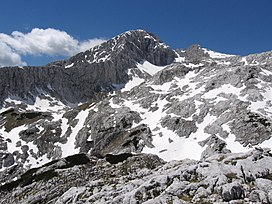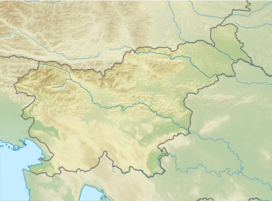
The Triglav Lakes Valley is a rocky hanging valley in the Julian Alps in Slovenia, below the sheer sides of Mount Tičarica and Mount Zelnarica southwest of Triglav. The valley is also called the Seven Lakes Valley, although there are ten and not seven lakes in the valley. It is above the tree line and is geologically alpine karst; therefore it has also been termed the Sea of Stone Valley.
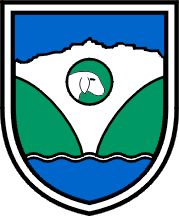
The Municipality of Jezersko is a municipality in northern Slovenia. In 1995, Jezersko became part of Preddvor and became an independent municipality in 1998. Originally located in the historic region of Carinthia, it became part of the Upper Carniola Statistical Region in 2005. The seat of the municipality is the town of Zgornje Jezersko.

Stol or Hochstuhl, at 2,236 m (7,336 ft), is the highest mountain of the Karawanks and straddles the border between Slovenia and Austria.

Kočna at 2,540 metres (8,330 ft) high, is the second-highest mountain in the Kamnik–Savinja Alps and the westernmost peak of the Grintovec Range. Its prominent and easily recognized peak is visible from far around. The mountain has two peaks: the higher Jezersko Kočna and the nearby lower Kokra Kočna.

Storžič is the highest mountain in the western part of the Kamnik–Savinja Alps. The top is a nicely shaped cone, from which the mountain got its name. Storžič has a good panoramic view. To the south are the Ljubljana Basin, Mount Krim, the Javornik Hills, Mount Snežnik, the Nanos Plateau, and the Škofja Loka Hills. To the west are the Julian Alps with prominent Mount Triglav. To the north are the Karawanks with Mount Stol, Mount Begunjščica, and Mount Košuta. To the east are the Jezersko Cirque, Mount Grintovec, the Kalce Ridge and Mount Krvavec.

Ojstrica is a mountain in the eastern part of the Kamnik Alps with a pyramid-shaped top that is visible from far away. The name Ojstrica derives from the Slovene word oster 'sharp'. There is a 600-meter (2,000 ft) high wall on its northern side to the bottom of the Logar Valley. The eastern side, down to the Roban Cirque, also has a high wall. There are several climbing routes.
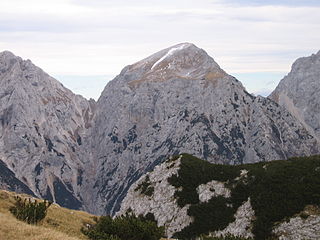
Brana is a ridge mountain of the Kamnik Alps in northern Slovenia. It is located between the Logar Valley to the north and the Kamnik Bistrica Valley to the south. The mountain is part of the central Kamnik group, a long ridge that includes the highest peaks of the range such as Grintovec, Kočna, and Skuta. Brana is sometimes climbed as part of a long traverse of the entire Kamnik ridge.
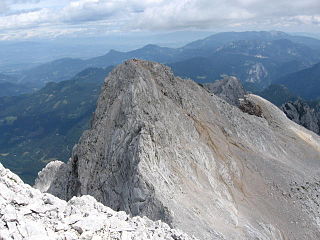
Carinthia Mount Rinka or the Cross, with an elevation of 2,433 metres (7,982 ft), is a mountain in the central Kamnik–Savinja Alps in northern Slovenia. It is connected via a pass with Carniola Mount Rinka, the northern ridge descends to the Jezersko Pass and the Savinja Pass, whereas the western ridge with Styria Mount Rinka ends with the Turski Žleb Ravine. There is also the fourth Rinka, called Little Mount Rinka. The names of the mountains reflect their positions at the border between the traditional Slovene regions of Carinthia, Carniola, and Styria.
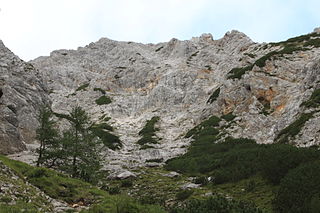
Cold Mountain is a 2,203-meter (7,228 ft) mountain in the Kamnik Alps. Cold Mountain rises over three valleys: the Logar Valley, the Matk Cirque, and the Vellach Combe. It is rarely visited because it is relatively difficult to ascend with many exposed areas. The border with Austria runs along the northern and western side, and until 1967 it was difficult to access because of political problems. Its first climbers had problems scaling it. In 1876, Robert von Lendenfeld and a guide named Matijevec from Luče reached the western peak and they descended, thinking they had reached the highest peak. In 1877, Karl Blodig tried two times, but quit due to weather well below the top. In the same year Johannes Frischauf, Piskernik, and Matek finally conquered the top. The Frischauf Lodge on Okrešelj is named after him.

The Kalce Ridge is a 2,224-metre-high (7,297 ft) mountain of the Kamnik–Savinja Alps in northern Slovenia. It is the highest peak of the Krvavec Group.
The Slovenian Mountain Hiking Trail, sometimes also called Transverzala, is a route from Maribor to Ankaran. It covers most of the Slovenian mountain areas including Pohorje, the Julian Alps, the Kamnik-Savinja Alps, the Karawanks, and the southwestern part of Slovenia. It is the oldest hiking track in Europe.

The Kamnik Saddle Lodge is a mountain hostel located just below Kamnik Saddle, with Mount Brana to its west and Mount Planjava to its east, and the Kamnik Bistrica Valley to its south. On its north is a steep descent toward the Logar Valley, home to Rinka Falls.

The Storžič Lodge is a mountain hostel in the upper part of the Lomščica Valley, near the Jesenje Pasture in northwestern Slovenia. The first lodge was built in 1938 and was called the Verbič Lodge ; it caught fire one year later. It burned in 1941 when German forces attacked the Storžič Battalion. The current brown shingled hut was built in 1951.

Raduha is a mountain in the eastern part of Kamnik–Savinja Alps in northern Slovenia.

The Smrekovec Lodge is a mountain hostel on the southern slope of the Smrekovec Mountains in the Kamnik–Savinja Alps. The first lodge was built in 1933, but it was burned down during World War II. A new lodge was built in 1951, and expanded in 1976–77.

The Zois Lodge at Kokra Saddle is a mountain hostel that stands on Kokra Saddle, part of the Kamnik–Savinja Alps. It is named after the brothers Karl Zois (1756–1799), and Sigmund Zois (1747–1819).

The Kocbek Lodge at Korošica is a mountain lodge standing on the Korošica Pasture on the Dleskovec Plateau, below the southern slope of Mount Ojstrica. It is named after Fran Kocbek, an early promoter of mountain hiking in the Kamnik–Savinja Alps. The first lodge, which was built in 1876, burned in 1881. A year later a new one was built. During World War II, it was captured by the Germans. It was expanded and modified from 1969 to 1973. The lodge was destroyed by a fire on October 20, 2017.
The Frischauf Lodge at Okrešelj is a mountain lodge that stands above the Logar Valley in northern Slovenia. It is surrounded by the following peaks: Cold Mountain, Styria Mount Rinka, Carinthia Mount Rinka, and Mount Turska. Nearby is 80-meter (260 ft) Rinka Falls. The lodge is named after Johannes Frischauf, and the first lodge was built in 1876 by an Austro-German hiking club. In 1907 it was destroyed by an avalanche and rebuilt again in 1908. In 1991 it was expanded and modernized.

The Czech Lodge at Spodnje Ravni is a mountain hostel that stands on the Spodnje Ravni Cirque above the Ravne Combe below the northern part of Mount Grintovec and the Long Ridge. It is named after the Czechs from Prague who built it in 1900. In the 1970s, it was renovated, but the Czech architectural style remained. It is managed by the Jezersko Mountaineering Club. Its groundskeeper was for 40 years Andrej Karničar, then for 10 ten years Tone Karničar, and since July 2015 Karmen Karničar.

Begunjščica is a ridge mountain in the Karawanks. It rises from the western Smokuč mountain pasture to St. Anne on its eastern side. The mountain has three main peaks, the highest being Big Peak. The western Middle Peak lies a little lower, and the lowest is Begunje Mount Vrtača. Its southern slopes rise over the Draga Valley. The ascent of the mountain is relatively easy and possible throughout the year. In the winter and early spring conditions are favourable for ski touring.
